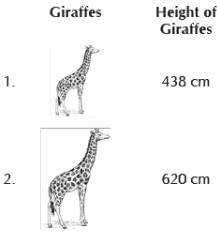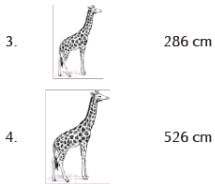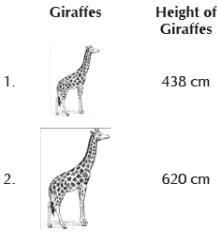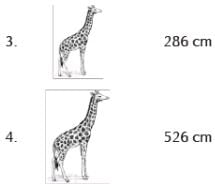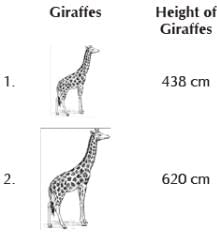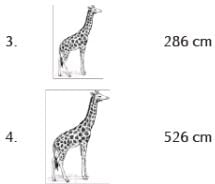All Exams >
Class 5 >
Math Olympiad for Class 5 >
All Questions
All questions of Measurement for Class 5 Exam
If the cost of 1 litre of cough syrup is Rs 480. 40, find the cost of 500 ml.
- a)Rs 200.40
- b)Rs 220.40
- c)Rs 260.40
- d)Rs 240.20
Correct answer is option 'D'. Can you explain this answer?
If the cost of 1 litre of cough syrup is Rs 480. 40, find the cost of 500 ml.
a)
Rs 200.40
b)
Rs 220.40
c)
Rs 260.40
d)
Rs 240.20
|
|
Stoneridge Institute answered |
Cost of 1000ml cough syrup=480.40
Cost of 500ml cough syrup=480.40/1000×500
= 480.40/2
= Rs. 240.20
Cost of 500ml cough syrup=480.40/1000×500
= 480.40/2
= Rs. 240.20
Shraddha has written following statements about the metric unit she would use to measure some objects. Find the incorrect sentence among them:
1. Centimetre is used to measure the length of a pencil.
2. Kilometre is used to measure distance from any city to another.
3. Metre is used to measure depth of a bucket.
4. Metre is used to measure height of a tree.
- a)2
- b)3
- c)4
- d)1
Correct answer is option 'B'. Can you explain this answer?
Shraddha has written following statements about the metric unit she would use to measure some objects. Find the incorrect sentence among them:
1. Centimetre is used to measure the length of a pencil.
2. Kilometre is used to measure distance from any city to another.
3. Metre is used to measure depth of a bucket.
4. Metre is used to measure height of a tree.
1. Centimetre is used to measure the length of a pencil.
2. Kilometre is used to measure distance from any city to another.
3. Metre is used to measure depth of a bucket.
4. Metre is used to measure height of a tree.
a)
2
b)
3
c)
4
d)
1
|
|
Natasha Chikonkolo answered |
The correct answer is B which is 3
A jar can hold 4 l 250 ml honey. How much honey will be needed to fill 4 jars?- a)16 litres
- b)15 litres
- c)17 litres
- d)17 l 250 ml
Correct answer is option 'C'. Can you explain this answer?
A jar can hold 4 l 250 ml honey. How much honey will be needed to fill 4 jars?
a)
16 litres
b)
15 litres
c)
17 litres
d)
17 l 250 ml
|
|
Harshad Datta answered |
Required money = 4 × (4 l + 250) ml
= 16 l + 1000 ml
= 16 l + 1 l = 17 l
= 16 l + 1000 ml
= 16 l + 1 l = 17 l
A carpenter was putting up a shelf. Shelf needed to be 86 cm long but piece of wood he had was 1 m and 26 m long. His saw was 33 cm long. How much did he have to cut off the piece of wood to make it fit?- a)40 cm
- b)43 cm
- c)50 cm
- d)53 cm
Correct answer is option 'A'. Can you explain this answer?
A carpenter was putting up a shelf. Shelf needed to be 86 cm long but piece of wood he had was 1 m and 26 m long. His saw was 33 cm long. How much did he have to cut off the piece of wood to make it fit?
a)
40 cm
b)
43 cm
c)
50 cm
d)
53 cm
|
|
Maulik Chauhan answered |
The length of the wood = 1 m and 26 cm
= 126 cm.
Length of shelf = 86 cm.
Length he needs to cut off = 126 cm - 86 cm
= 40 cm.
A container has 2550 ml of water. How many litres and millilitres of water is in the container?- a)2l 500 ml
- b)2l 525 ml
- c)2l 505 ml
- d)2l 550 ml
Correct answer is option 'D'. Can you explain this answer?
A container has 2550 ml of water. How many litres and millilitres of water is in the container?
a)
2l 500 ml
b)
2l 525 ml
c)
2l 505 ml
d)
2l 550 ml
|
|
Ashwini Chauhan answered |
We have 2550 ml = (2000 + 550) ml
= 2000 ml + 550 ml
= 2 l 550 ml
= 2000 ml + 550 ml
= 2 l 550 ml
The height of a male basketball player is about- a)2 mm
- b)2 cm
- c)2 m
- d)2 km
Correct answer is option 'C'. Can you explain this answer?
The height of a male basketball player is about
a)
2 mm
b)
2 cm
c)
2 m
d)
2 km

|
Rakshita Verma answered |
The answer is c because the basketball player height should not be in millimetres or centimetres and you know that no ones height is in kilometres so the answer is 2m. Please follow me.
To convert days into hours we multiply the no. of days by- a)20
- b)30
- c)24
- d)31
Correct answer is option 'C'. Can you explain this answer?
To convert days into hours we multiply the no. of days by
a)
20
b)
30
c)
24
d)
31

|
Luv Kumar answered |
Because in one day there is 24 hours
Shraddha needs 6 containers which can hold 15 l 600 ml oil. Find the capacity of each container.- a)2l 500 ml
- b)2l 600 ml
- c)3 l 200 ml
- d)2l 100 ml
Correct answer is option 'B'. Can you explain this answer?
Shraddha needs 6 containers which can hold 15 l 600 ml oil. Find the capacity of each container.
a)
2l 500 ml
b)
2l 600 ml
c)
3 l 200 ml
d)
2l 100 ml
|
|
Maulik Chauhan answered |
To find the capacity of each container, we need to divide the total amount of oil by the number of containers required. In this case, Shraddha needs 6 containers and each container can hold 15 liters 600 milliliters of oil.
Let's convert the milliliters to liters for easier calculation. There are 1000 milliliters in 1 liter. So, 600 milliliters is equal to 600/1000 = 0.6 liters.
Now, let's calculate the total amount of oil that can be stored in all 6 containers:
Total amount of oil = 6 containers * (15 liters + 0.6 liters) = 6 containers * 15.6 liters
Therefore, the capacity of each container is equal to the total amount of oil divided by the number of containers:
Capacity of each container = (6 containers * 15.6 liters) / 6 containers
Simplifying the expression, we get:
Capacity of each container = 15.6 liters
So, the correct answer is option 'B', which is 2 liters 600 milliliters or 2.6 liters.
Let's convert the milliliters to liters for easier calculation. There are 1000 milliliters in 1 liter. So, 600 milliliters is equal to 600/1000 = 0.6 liters.
Now, let's calculate the total amount of oil that can be stored in all 6 containers:
Total amount of oil = 6 containers * (15 liters + 0.6 liters) = 6 containers * 15.6 liters
Therefore, the capacity of each container is equal to the total amount of oil divided by the number of containers:
Capacity of each container = (6 containers * 15.6 liters) / 6 containers
Simplifying the expression, we get:
Capacity of each container = 15.6 liters
So, the correct answer is option 'B', which is 2 liters 600 milliliters or 2.6 liters.
To convert hours into seconds, we multiply the number of hours by- a)60
- b)1200
- c)3600
- d)300
Correct answer is option 'C'. Can you explain this answer?
To convert hours into seconds, we multiply the number of hours by
a)
60
b)
1200
c)
3600
d)
300
|
|
Ruchi Basu answered |
Conversion of Hours to Seconds:
To convert hours into seconds, we need to consider the fact that there are 60 minutes in an hour, and 60 seconds in a minute. Therefore, to convert hours to seconds, we need to multiply the number of hours by the number of seconds in an hour, which is 3600.
Calculation:
- 1 hour = 60 minutes
- 1 minute = 60 seconds
- 1 hour = 60 x 60 = 3600 seconds
Formula:
- Number of hours x 3600 = Number of seconds
Example:
If we have 2 hours, the conversion to seconds would be:
2 hours x 3600 = 7200 seconds
Therefore, to convert hours into seconds, we always multiply the number of hours by 3600.
To convert hours into seconds, we need to consider the fact that there are 60 minutes in an hour, and 60 seconds in a minute. Therefore, to convert hours to seconds, we need to multiply the number of hours by the number of seconds in an hour, which is 3600.
Calculation:
- 1 hour = 60 minutes
- 1 minute = 60 seconds
- 1 hour = 60 x 60 = 3600 seconds
Formula:
- Number of hours x 3600 = Number of seconds
Example:
If we have 2 hours, the conversion to seconds would be:
2 hours x 3600 = 7200 seconds
Therefore, to convert hours into seconds, we always multiply the number of hours by 3600.
Direction: Read the table given below and answer the questions :
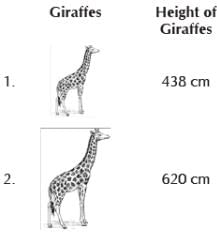
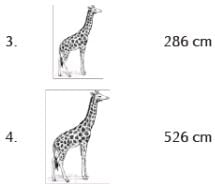 How much taller is Giraffe 2 than 1?
How much taller is Giraffe 2 than 1?- a)180 cm
- b)181 cm
- c)182 cm
- d)183 cm
Correct answer is option 'C'. Can you explain this answer?
Direction: Read the table given below and answer the questions :




How much taller is Giraffe 2 than 1?
a)
180 cm
b)
181 cm
c)
182 cm
d)
183 cm

|
Kds Coaching answered |
- To find how much taller Giraffe 2 is than Giraffe 1, we need to subtract the height of Giraffe 1 from the height of Giraffe 2.
- According to the table, Giraffe 2 is 510 cm tall, and Giraffe 1 is 328 cm tall.
- Required height = 620 – 438 = 182 cm
- Therefore, Giraffe 2 is 182 cm taller than Giraffe 1.
- According to the table, Giraffe 2 is 510 cm tall, and Giraffe 1 is 328 cm tall.
- Required height = 620 – 438 = 182 cm
- Therefore, Giraffe 2 is 182 cm taller than Giraffe 1.
Direction: Add the following capacities:17 l 708 ml and 13 l 993 ml- a)30 l 700 ml
- b)31 l 701 ml
- c)31 l 700 ml
- d)32 l 750 ml
Correct answer is option 'B'. Can you explain this answer?
Direction: Add the following capacities:
17 l 708 ml and 13 l 993 ml
a)
30 l 700 ml
b)
31 l 701 ml
c)
31 l 700 ml
d)
32 l 750 ml
|
|
Aaditya Chavan answered |
To add the given capacities, we need to add the liters and the milliliters separately.
Given Capacities:
17 l 708 ml
13 l 993 ml
Adding the liters:
17 l + 13 l = 30 l
Adding the milliliters:
708 ml + 993 ml = 1701 ml
Converting milliliters to liters:
1701 ml = 1701/1000 l = 1.701 l
Adding the total liters and milliliters:
30 l + 1.701 l = 31.701 l
Since we need to express the answer in liters and milliliters, we need to round off the milliliters to the nearest whole number.
Rounding off 0.701 to the nearest whole number, we get 1 ml.
Therefore, the final answer is 31 l 701 ml.
Hence, option B (31 l 701 ml) is the correct answer.
Given Capacities:
17 l 708 ml
13 l 993 ml
Adding the liters:
17 l + 13 l = 30 l
Adding the milliliters:
708 ml + 993 ml = 1701 ml
Converting milliliters to liters:
1701 ml = 1701/1000 l = 1.701 l
Adding the total liters and milliliters:
30 l + 1.701 l = 31.701 l
Since we need to express the answer in liters and milliliters, we need to round off the milliliters to the nearest whole number.
Rounding off 0.701 to the nearest whole number, we get 1 ml.
Therefore, the final answer is 31 l 701 ml.
Hence, option B (31 l 701 ml) is the correct answer.
The distance from New York (US) to Southampton (UK) is about- a)5,500 mm
- b)5,500 cm
- c)5,500 m
- d)5,500 km
Correct answer is option 'D'. Can you explain this answer?
The distance from New York (US) to Southampton (UK) is about
a)
5,500 mm
b)
5,500 cm
c)
5,500 m
d)
5,500 km
|
|
Aashna Yadav answered |
The correct answer is option 'D' - 5,500 km.
Explanation:
1. Understanding the question:
The question is asking for the distance between New York (US) and Southampton (UK). We need to determine the appropriate unit of measurement to express this distance accurately.
2. Units of measurement:
Distance can be measured in various units, such as millimeters (mm), centimeters (cm), meters (m), and kilometers (km). Each unit represents a different magnitude.
3. Choosing the appropriate unit:
To determine the appropriate unit of measurement for the distance between New York and Southampton, we need to consider the magnitude of the distance. The given options include mm, cm, m, and km.
4. Converting units:
To convert between units, we need to know the conversion factors. Here are the conversion factors for the given units:
- 1 km = 1,000 m
- 1 m = 100 cm
- 1 cm = 10 mm
5. Analyzing the options:
a) 5,500 mm: This unit is too small for the distance between New York and Southampton. It would represent a very short distance.
b) 5,500 cm: This unit is also too small. It would still represent a relatively short distance.
c) 5,500 m: This unit is larger than cm and mm but still not sufficient to represent the distance between the two cities.
d) 5,500 km: This unit is the largest among the given options. It represents a much larger distance and is the most appropriate unit for the distance between New York and Southampton.
6. Final answer:
Therefore, the correct answer is option 'D' - 5,500 km.
Explanation:
1. Understanding the question:
The question is asking for the distance between New York (US) and Southampton (UK). We need to determine the appropriate unit of measurement to express this distance accurately.
2. Units of measurement:
Distance can be measured in various units, such as millimeters (mm), centimeters (cm), meters (m), and kilometers (km). Each unit represents a different magnitude.
3. Choosing the appropriate unit:
To determine the appropriate unit of measurement for the distance between New York and Southampton, we need to consider the magnitude of the distance. The given options include mm, cm, m, and km.
4. Converting units:
To convert between units, we need to know the conversion factors. Here are the conversion factors for the given units:
- 1 km = 1,000 m
- 1 m = 100 cm
- 1 cm = 10 mm
5. Analyzing the options:
a) 5,500 mm: This unit is too small for the distance between New York and Southampton. It would represent a very short distance.
b) 5,500 cm: This unit is also too small. It would still represent a relatively short distance.
c) 5,500 m: This unit is larger than cm and mm but still not sufficient to represent the distance between the two cities.
d) 5,500 km: This unit is the largest among the given options. It represents a much larger distance and is the most appropriate unit for the distance between New York and Southampton.
6. Final answer:
Therefore, the correct answer is option 'D' - 5,500 km.
Rohan bought a 50 lt container of oil. He used 44 litres 300 ml of it. How much oil is left?- a)5 l 700 ml
- b)6 l 700 ml
- c)5 l 300 ml
- d)6 l 300 ml
Correct answer is option 'A'. Can you explain this answer?
Rohan bought a 50 lt container of oil. He used 44 litres 300 ml of it. How much oil is left?
a)
5 l 700 ml
b)
6 l 700 ml
c)
5 l 300 ml
d)
6 l 300 ml
|
|
Subhankar Kulkarni answered |
Calculation:
To find out how much oil is left, we need to subtract the amount of oil used from the total amount of oil Rohan bought.
Given:
Total amount of oil bought = 50 litres
Amount of oil used = 44 litres 300 ml
Converting ml to litres:
1 litre = 1000 ml
Therefore, 300 ml = 0.3 litres
Subtracting the amount of oil used from the total amount:
50 litres - 44.3 litres = 5.7 litres
Therefore, the amount of oil left is 5 litres 700 ml.
Therefore, the correct answer is option A) 5 l 700 ml.
To find out how much oil is left, we need to subtract the amount of oil used from the total amount of oil Rohan bought.
Given:
Total amount of oil bought = 50 litres
Amount of oil used = 44 litres 300 ml
Converting ml to litres:
1 litre = 1000 ml
Therefore, 300 ml = 0.3 litres
Subtracting the amount of oil used from the total amount:
50 litres - 44.3 litres = 5.7 litres
Therefore, the amount of oil left is 5 litres 700 ml.
Therefore, the correct answer is option A) 5 l 700 ml.
The no. of days in the month of February in a leap year is- a)30
- b)29
- c)31
- d)All of them
Correct answer is option 'B'. Can you explain this answer?
The no. of days in the month of February in a leap year is
a)
30
b)
29
c)
31
d)
All of them

|
Gayathri M answered |
1 Year is 365 days and 6hours . 6×4=24 .24 hours = 1day .so therefore we are adding a day to February because it is the stortest month.
The diameter of your little finger is about- a)1.5 mm
- b)1.5 cm
- c)1.5 m
- d)1.5 km
Correct answer is option 'B'. Can you explain this answer?
The diameter of your little finger is about
a)
1.5 mm
b)
1.5 cm
c)
1.5 m
d)
1.5 km
|
|
Rajeev Saha answered |
Explanation:
The diameter of your little finger is about 1.5 cm.
To understand why the correct answer is option 'B', let's first understand what diameter means and how it relates to the little finger.
Diameter:
The diameter is a term used to describe the distance across a circle passing through its center. In simpler terms, it is the length of a straight line passing through the center of a circle and touching two points on its circumference.
The Little Finger:
The little finger, also known as the pinky finger, is the smallest and shortest finger on the human hand. It is located on the outer side of the hand, next to the ring finger. The little finger is made up of several bones called phalanges, which are connected by joints.
Measurement of Diameter:
To measure the diameter of the little finger, we can use a ruler or a measuring tape. Place the ruler or tape horizontally across the widest part of the finger, which is usually near the base. Note the measurement where the ruler or tape intersects the opposite sides of the finger.
Approximate Diameter of the Little Finger:
The diameter of the little finger may vary slightly from person to person, but on average, it is about 1.5 cm. This means that if you were to measure the distance across the little finger at its widest point, it would be approximately 1.5 cm.
Options Explanation:
Let's evaluate each option to understand why option 'B' is the correct answer.
a) 1.5 mm: This measurement is too small for the diameter of a little finger. It is roughly the thickness of a paperclip.
b) 1.5 cm: This is the correct answer. As explained earlier, the diameter of the little finger is approximately 1.5 cm.
c) 1.5 m: This measurement is too big for the diameter of a little finger. It is roughly the height of an average adult.
d) 1.5 km: This measurement is extremely large and not relevant to the diameter of a little finger. It is roughly the distance between two cities.
Therefore, the correct answer is option 'B' (1.5 cm), as it accurately represents the approximate diameter of a little finger.
The diameter of your little finger is about 1.5 cm.
To understand why the correct answer is option 'B', let's first understand what diameter means and how it relates to the little finger.
Diameter:
The diameter is a term used to describe the distance across a circle passing through its center. In simpler terms, it is the length of a straight line passing through the center of a circle and touching two points on its circumference.
The Little Finger:
The little finger, also known as the pinky finger, is the smallest and shortest finger on the human hand. It is located on the outer side of the hand, next to the ring finger. The little finger is made up of several bones called phalanges, which are connected by joints.
Measurement of Diameter:
To measure the diameter of the little finger, we can use a ruler or a measuring tape. Place the ruler or tape horizontally across the widest part of the finger, which is usually near the base. Note the measurement where the ruler or tape intersects the opposite sides of the finger.
Approximate Diameter of the Little Finger:
The diameter of the little finger may vary slightly from person to person, but on average, it is about 1.5 cm. This means that if you were to measure the distance across the little finger at its widest point, it would be approximately 1.5 cm.
Options Explanation:
Let's evaluate each option to understand why option 'B' is the correct answer.
a) 1.5 mm: This measurement is too small for the diameter of a little finger. It is roughly the thickness of a paperclip.
b) 1.5 cm: This is the correct answer. As explained earlier, the diameter of the little finger is approximately 1.5 cm.
c) 1.5 m: This measurement is too big for the diameter of a little finger. It is roughly the height of an average adult.
d) 1.5 km: This measurement is extremely large and not relevant to the diameter of a little finger. It is roughly the distance between two cities.
Therefore, the correct answer is option 'B' (1.5 cm), as it accurately represents the approximate diameter of a little finger.
Chapter doubts & questions for Measurement - Math Olympiad for Class 5 2025 is part of Class 5 exam preparation. The chapters have been prepared according to the Class 5 exam syllabus. The Chapter doubts & questions, notes, tests & MCQs are made for Class 5 2025 Exam. Find important definitions, questions, notes, meanings, examples, exercises, MCQs and online tests here.
Chapter doubts & questions of Measurement - Math Olympiad for Class 5 in English & Hindi are available as part of Class 5 exam.
Download more important topics, notes, lectures and mock test series for Class 5 Exam by signing up for free.
Math Olympiad for Class 5
43 videos|123 docs|60 tests
|

Contact Support
Our team is online on weekdays between 10 AM - 7 PM
Typical reply within 3 hours
|
Free Exam Preparation
at your Fingertips!
Access Free Study Material - Test Series, Structured Courses, Free Videos & Study Notes and Prepare for Your Exam With Ease

 Join the 10M+ students on EduRev
Join the 10M+ students on EduRev
|

|
Create your account for free
OR
Forgot Password
OR
Signup to see your scores
go up within 7 days!
Access 1000+ FREE Docs, Videos and Tests
Takes less than 10 seconds to signup



